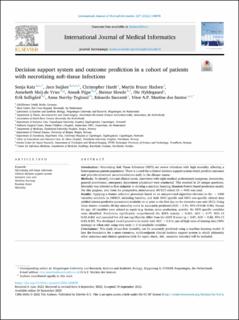| dc.contributor.author | Katz, Sonja | |
| dc.contributor.author | Suijker, Jaco | |
| dc.contributor.author | Hardt, Christopher | |
| dc.contributor.author | Madsen, Martin Bruun | |
| dc.contributor.author | Vries, Annebeth Meij-de | |
| dc.contributor.author | Pijpe, Anouk | |
| dc.contributor.author | Skrede, Steinar | |
| dc.contributor.author | Hyldegaard, Ole | |
| dc.contributor.author | Solligård, Erik | |
| dc.contributor.author | Norrby-Teglund, Anna | |
| dc.contributor.author | Saccenti, Edoardo | |
| dc.contributor.author | Martins dos Santos, Vitor A.P. | |
| dc.date.accessioned | 2023-01-04T11:35:21Z | |
| dc.date.available | 2023-01-04T11:35:21Z | |
| dc.date.created | 2022-10-19T12:39:06Z | |
| dc.date.issued | 2022 | |
| dc.identifier.issn | 1386-5056 | |
| dc.identifier.uri | https://hdl.handle.net/11250/3040896 | |
| dc.description.abstract | Introduction:
Necrotizing Soft Tissue Infections (NSTI) are severe infections with high mortality affecting a heterogeneous patient population. There is a need for a clinical decision support system which predicts outcomes and provides treatment recommendations early in the disease course.
Methods:
To identify relevant clinical needs, interviews with eight medical professionals (surgeons, intensivists, general practitioner, emergency department physician) were conducted. This resulted in 24 unique questions. Mortality was selected as first endpoint to develop a machine learning (Random Forest) based prediction model. For this purpose, data from the prospective, international INFECT cohort (N = 409) was used.
Results:
Applying a feature selection procedure based on an unsupervised algorithm (Boruta) to the > 1000 variables available in INFECT, including baseline, and both NSTI specific and NSTI non-specific clinical data yielded sixteen predictive parameters available on or prior to the first day on the intensive care unit (ICU). Using these sixteen variables 30-day mortality could be accurately predicted (AUC = 0.91, 95% CI 0.88–0.96). Except for age, all variables were related to sepsis (e.g. lactate, urine production, systole). No NSTI-specific variables were identified. Predictions significantly outperformed the SOFA score(p < 0.001, AUC = 0.77, 95% CI 0.69–0.84) and exceeded but did not significantly differ from the SAPS II score (p = 0.07, AUC = 0.88, 95% CI 0.83–0.92). The developed model proved to be stable with AUC > 0.8 in case of high rates of missing data (50% missing) or when only using very early (<1 h) available variables.
Conclusions:
This study shows that mortality can be accurately predicted using a machine learning model. It lays the foundation for a more extensive, multi-endpoint clinical decision support system in which ultimately other outcomes and clinical questions (risk for septic shock, AKI, causative microbe) will be included. | en_US |
| dc.language.iso | eng | en_US |
| dc.publisher | Elsevier | en_US |
| dc.rights | Navngivelse 4.0 Internasjonal | * |
| dc.rights.uri | http://creativecommons.org/licenses/by/4.0/deed.no | * |
| dc.title | Decision support system and outcome prediction in a cohort of patients with necrotizing soft-tissue infections | en_US |
| dc.type | Journal article | en_US |
| dc.type | Peer reviewed | en_US |
| dc.description.version | publishedVersion | en_US |
| dc.rights.holder | Copyright 2022 The Author(s) | en_US |
| dc.source.articlenumber | 104878 | en_US |
| cristin.ispublished | true | |
| cristin.fulltext | original | |
| cristin.qualitycode | 2 | |
| dc.identifier.doi | 10.1016/j.ijmedinf.2022.104878 | |
| dc.identifier.cristin | 2062766 | |
| dc.source.journal | International Journal of Medical Informatics | en_US |
| dc.identifier.citation | International Journal of Medical Informatics. 2022, 167, 104878. | en_US |
| dc.source.volume | 167 | en_US |

